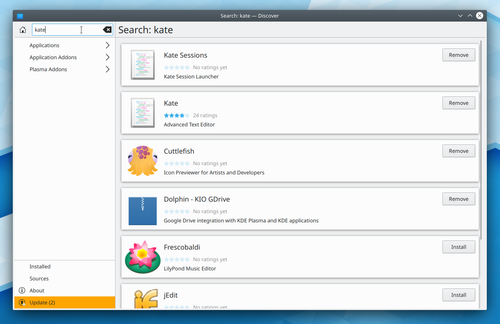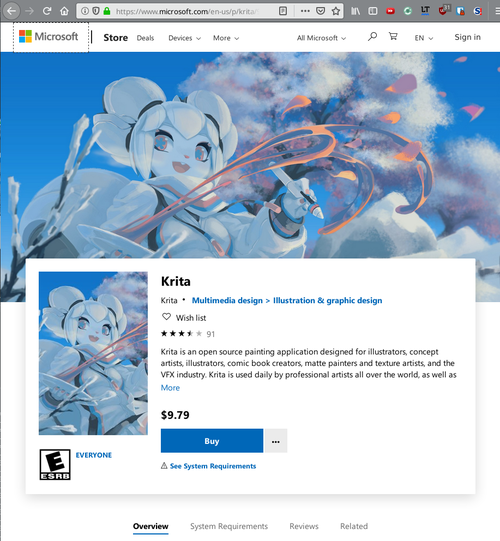Tutorials/Install KDE software/en: Difference between revisions
Importing a new version from external source |
Updating to match new version of source page |
||
| (9 intermediate revisions by the same user not shown) | |||
| Line 10: | Line 10: | ||
=== Discover === | === Discover === | ||
Discover is the KDE Software Center and | Discover is the KDE Software Center and works with every distribution that supports [https://en.wikipedia.org/wiki/AppStream AppStream] (e.g. Ubuntu, Debian, ArchLinux, openSUSE, Red Hat, Fedora). If you want more info about Discover, visit the [[Special:myLanguage/Discover|Discover]] page. | ||
| Line 17: | Line 17: | ||
=== openSUSE - YaST === | === openSUSE - YaST === | ||
Along with Discover, openSUSE comes with its own software management tool, YaST Software Management. | |||
Search for <code>YaST Software Management</code> in the application launcher. Open YaST and click on the <menuchoice>Software Management</menuchoice> icon to start the package manager. | |||
[[ | [[File:Yast-package-management-1.png|center|500px|thumb|Searching for KDE in the YaST sofware management.]] | ||
Use the search field to find the package that you wish to install; you can search | Use the search field to find the package that you wish to install; you can search by the package name or the package description. You only need to enter part of the name. You will then be presented with a list of packages matching your search. Click the selection boxes for the packages to be installed and then click <menuchoice>Accept</menuchoice>. See [https://en.opensuse.org/Package_management this page] for more on package management and openSUSE. | ||
=== Windows Store === | === Windows Store === | ||
Some KDE | Some KDE applications are also available in the Windows Store. Some apps like [https://www.microsoft.com/en-us/p/krita/9n6x57zgrw96 Krita] and [https://www.microsoft.com/en-us/p/kstars/9pprz2qhlxtg KStars] are available in the Windows Store. | ||
[[File:WindowsStoreKrita.png|center|500px]] | |||
== From the command line == | == From the command line == | ||
If you find that using a package manager is unbearably slow, you will want to use command-line installation. This is much faster, but the disadvantage is that you need to know the exact name of the package you want to install. | If you find that using a graphical package manager is unbearably slow, you will want to use command-line installation. This is much faster, but the disadvantage is that you need to know the exact name of the package you want to install. To find out what commands you can use to search for packages on your system: Find your distribution's package manager below, [[Special:MyLanguage/Tutorials/Open_a_console|open a console]], and append <code>--help</code> to the name of your distribution's package manager. As an example, <code>dnf --help</code> will list the commands you can use for Fedora, but there are many and they can be confusing at first. | ||
=== openSUSE === | === openSUSE === | ||
| Line 42: | Line 44: | ||
With Ubuntu Linux you install software using '''apt'''. For example to install [[Special:myLanguage/KWrite|KWrite]] you will [[Special:MyLanguage/Tutorials/Open_a_console|open a console]] and enter | With Ubuntu Linux you install software using '''apt'''. For example to install [[Special:myLanguage/KWrite|KWrite]] you will [[Special:MyLanguage/Tutorials/Open_a_console|open a console]] and enter | ||
<code>sudo apt install kwrite</code> | <code>sudo apt install kwrite</code>. | ||
=== Fedora === | === Fedora === | ||
Fedora uses ''' | Fedora uses '''dnf''' so to install [[Special:myLanguage/KWrite|KWrite]] you would [[Special:MyLanguage/Tutorials/Open_a_console|open a console]] and type <code>dnf install kwrite</code>. If you are unsure of the name of a package, you can use ''dnf list'' with wildcards to see all the packages with a word as part of the package name — for example <code>dnf list *network*</code> will list all available packages with "network" as part of the name. Casting even wider, <code>dnf search mpeg</code> will list all packages that either have ''mpeg'' in the name or in the description of the package. | ||
=== Gentoo === | |||
With Gentoo you install software using '''emerge''', e.g. for [[Special:myLanguage/KWrite|KWrite]] you would [[Special:MyLanguage/Tutorials/Open_a_console|open a console]] and type <code>emerge --ask kwrite</code> (using ''--ask'' to get an overview of necessary dependencies and '''USE flag''' options before confirming). If you are unsure of the name of a package, you can use ''emerge --search'' to see all the packages with a word as part of the package name — e.g. <code>emerge --search network</code> will list all available packages with "network" as part of the name. | |||
=== Mageia | === Mageia === | ||
You can use '''urpmi''' to install KDE software from a command line. | You can use '''urpmi''' to install KDE software from a command line. Other useful commands can be found at [https://en.wikipedia.org/wiki/Urpmi Wikipedia's Urpmi page]. | ||
=== | === OpenMandriva Lx === | ||
With Arch | Most KDE software is installed already - you can use '''dnf''' to install additional packages. If you know what a package is called, you can use e.g. <code>dnf --refresh install kwrite</code>. If you don't know the package name, you can use <code>dnf --refresh search '*kde*'</code> to search (this example lists all packages that have "kde" as part of their name or description). | ||
<code>sudo pacman -S kwrite</code> | You can also use [[Special:myLanguage/Discover|Discover]] or <code>dnfdragora</code> as graphical frontends to package installation. | ||
=== Arch Linux and Manjaro === | |||
With Arch Linux and Arch-based distributions like Manjaro, you can install software using the '''pacman''' utility. For example, to install [[Special:myLanguage/KWrite|KWrite]] you will [[Special:MyLanguage/Tutorials/Open_a_console|open a console]] and enter the command | |||
<code>sudo pacman -S kwrite</code>. | |||
[[Category:Getting_Started]] | [[Category:Getting_Started]] | ||
=== Solus === | |||
Most KDE software is already installed on the Plasma edition. You can use '''eopkg''' to install, update, and remove software packages on any Solus edition. For example, to install [[Special:myLanguage/KWrite|KWrite]], which is included with the [[Special:myLanguage/Kate|Kate]] package, you will [[Special:MyLanguage/Tutorials/Open_a_console|open a console]] and enter <code>sudo eopkg it kate</code>. Other useful commands can be found on the [https://help.getsol.us/docs/user/package-management/basics Solus Package Management page]. | |||
Latest revision as of 17:15, 4 October 2024
Install KDE software
To install KDE software we recommend using the means of your distribution. Here is how you find your distribution's name and version.
From the GUI
Discover
Discover is the KDE Software Center and works with every distribution that supports AppStream (e.g. Ubuntu, Debian, ArchLinux, openSUSE, Red Hat, Fedora). If you want more info about Discover, visit the Discover page.

openSUSE - YaST
Along with Discover, openSUSE comes with its own software management tool, YaST Software Management.
Search for YaST Software Management in the application launcher. Open YaST and click on the icon to start the package manager.

Use the search field to find the package that you wish to install; you can search by the package name or the package description. You only need to enter part of the name. You will then be presented with a list of packages matching your search. Click the selection boxes for the packages to be installed and then click . See this page for more on package management and openSUSE.
Windows Store
Some KDE applications are also available in the Windows Store. Some apps like Krita and KStars are available in the Windows Store.

From the command line
If you find that using a graphical package manager is unbearably slow, you will want to use command-line installation. This is much faster, but the disadvantage is that you need to know the exact name of the package you want to install. To find out what commands you can use to search for packages on your system: Find your distribution's package manager below, open a console, and append --help to the name of your distribution's package manager. As an example, dnf --help will list the commands you can use for Fedora, but there are many and they can be confusing at first.
openSUSE
With openSUSE you install software using zypper
for example to install KWrite you will open a console and enter
zypper in kwrite.
Ubuntu
With Ubuntu Linux you install software using apt. For example to install KWrite you will open a console and enter
sudo apt install kwrite.
Fedora
Fedora uses dnf so to install KWrite you would open a console and type dnf install kwrite. If you are unsure of the name of a package, you can use dnf list with wildcards to see all the packages with a word as part of the package name — for example dnf list *network* will list all available packages with "network" as part of the name. Casting even wider, dnf search mpeg will list all packages that either have mpeg in the name or in the description of the package.
Gentoo
With Gentoo you install software using emerge, e.g. for KWrite you would open a console and type emerge --ask kwrite (using --ask to get an overview of necessary dependencies and USE flag options before confirming). If you are unsure of the name of a package, you can use emerge --search to see all the packages with a word as part of the package name — e.g. emerge --search network will list all available packages with "network" as part of the name.
Mageia
You can use urpmi to install KDE software from a command line. Other useful commands can be found at Wikipedia's Urpmi page.
OpenMandriva Lx
Most KDE software is installed already - you can use dnf to install additional packages. If you know what a package is called, you can use e.g. dnf --refresh install kwrite. If you don't know the package name, you can use dnf --refresh search '*kde*' to search (this example lists all packages that have "kde" as part of their name or description).
You can also use Discover or dnfdragora as graphical frontends to package installation.
Arch Linux and Manjaro
With Arch Linux and Arch-based distributions like Manjaro, you can install software using the pacman utility. For example, to install KWrite you will open a console and enter the command
sudo pacman -S kwrite.
Solus
Most KDE software is already installed on the Plasma edition. You can use eopkg to install, update, and remove software packages on any Solus edition. For example, to install KWrite, which is included with the Kate package, you will open a console and enter sudo eopkg it kate. Other useful commands can be found on the Solus Package Management page.

